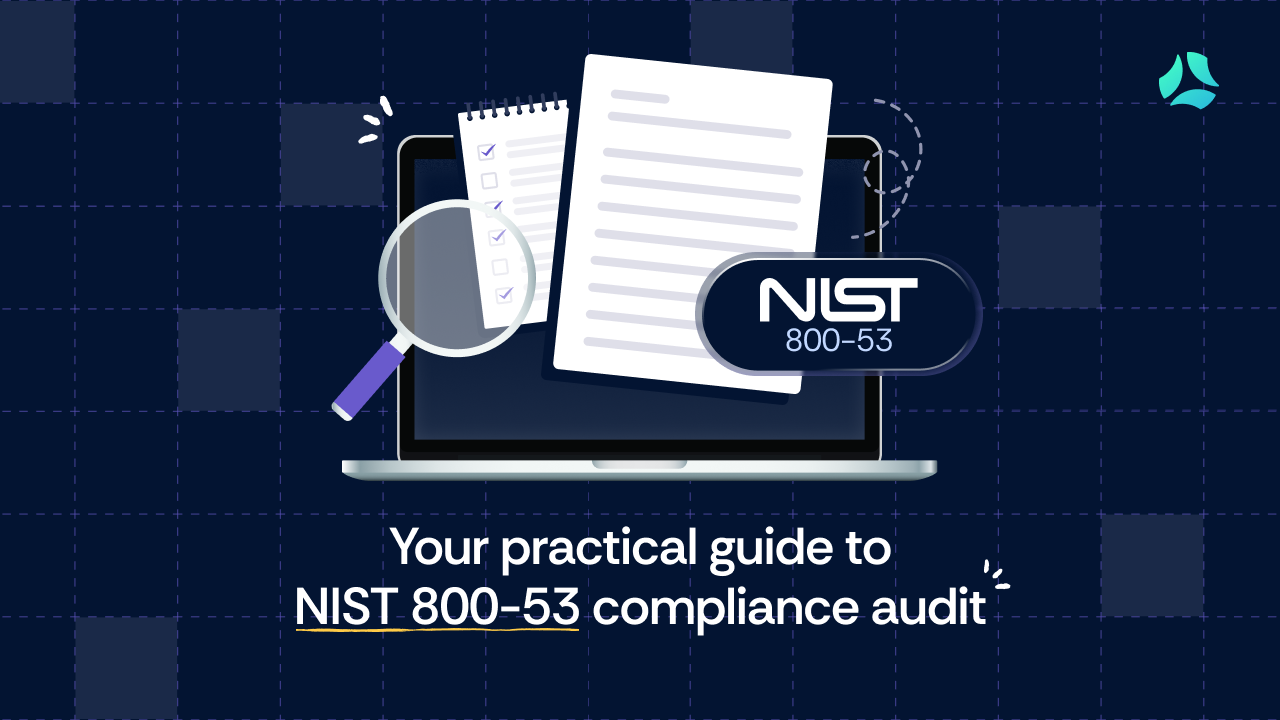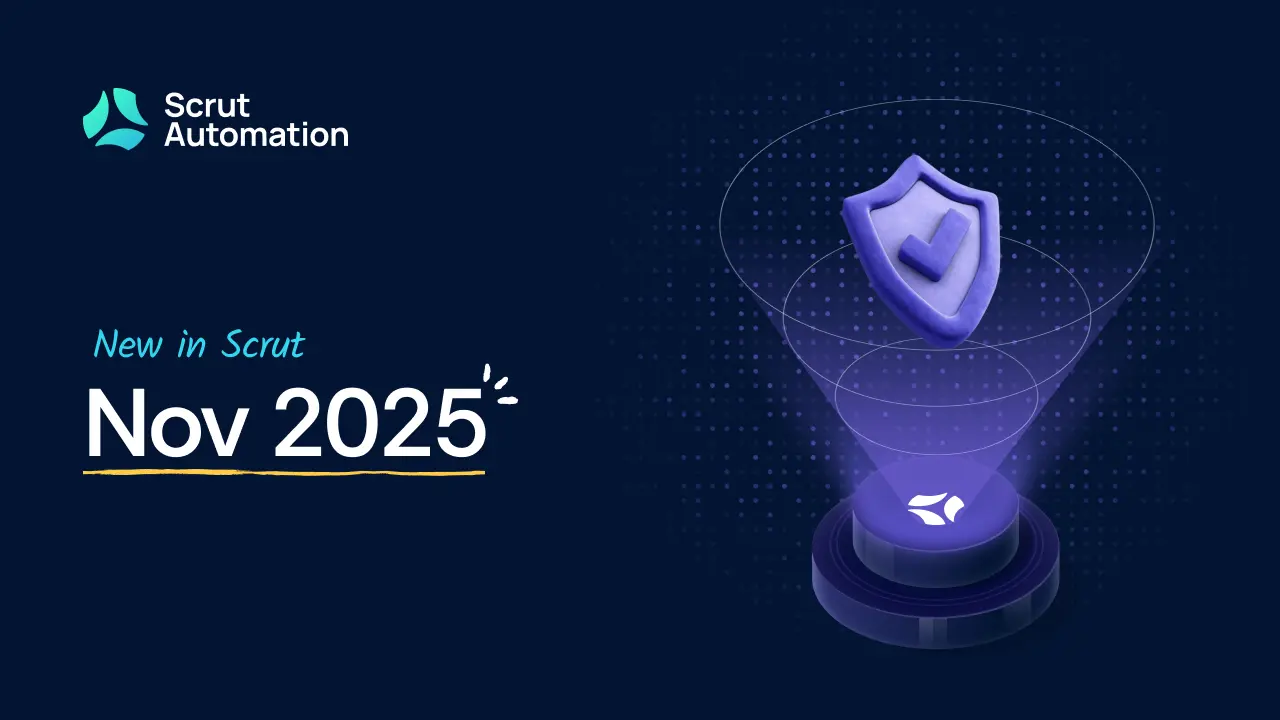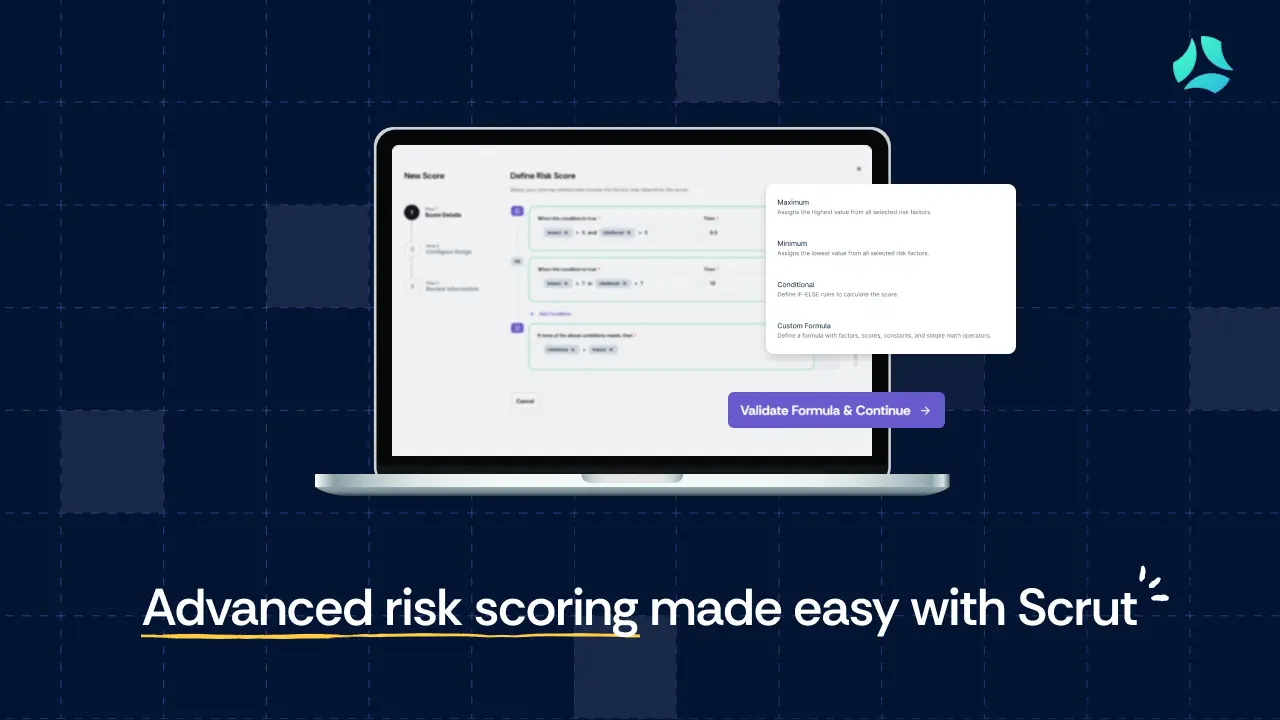NIST 800-53 compliance audit and checklist

Drowning in spreadsheets before your NIST 800-53 compliance audit? Or scrambling to collect evidence last-minute?
You’re not alone. Manual compliance processes slow you down, increase risk, and can block your path to federal contracts.
If you’re targeting U.S. government work that involves federal information systems or cloud services, compliance with the NIST 800-53 controls is mandatory. It’s a comprehensive catalog of security and privacy controls designed to safeguard U.S. federal information systems.
It outlines the security controls required for Federal Information Security Modernization Act (FISMA) compliance and is essential for FedRAMP authorization (for cloud providers).
But with its deep ties to the NIST Risk Management Framework (RMF), it’s far from plug-and-play.
Miss a step, and you could lose out on major contracts. Nail it, and you open the door to business growth. That’s where using a NIST 800-53 compliance checklist is essential.
This guide breaks it down: no jargon, no fluff. Just a practical checklist and clear steps to help you align with federal security standards and pass your audit with confidence.
Decoding the building blocks: NIST 800-53 controls and baselines
If you’re working with the U.S. government on projects involving FISMA or cloud services, complying with the NIST SP 800-53 security and privacy controls is mandatory. However, even if those requirements don't apply to you, the NIST SP 800-53 catalog, when applied through the RMF, remains one of the most comprehensive control sets you can use to strengthen your security posture.
This control catalog outlines over 1,000 controls, including technical, operational, and administrative controls, organized into 20 control families. However, you must note that the exact number of controls varies based on the application of control enhancements and tailoring.It gives you a structured, risk-based approach to protecting critical infrastructure, building customer trust, and scaling securely.
Control families
The following table summarizes the control families and what each involves:
Each control family addresses one or more of the diverse risks and threats, including hostile attacks, human errors, natural disasters, structural failures, and privacy risks. You can also employ controls from two or more families to mitigate a single threat.
For instance, the AU family helps mitigate several risks, such as external attacks, malicious insider activities, and unintentional human errors. Alternatively, you can reduce the risk of unauthorized access through a combination of the AC, IA, and PE control families.
Control baselines
With more than 1,000 controls in the NIST 800-53 catalog, the natural question is: Where do you even begin?
Trying to implement all of them isn’t realistic, and missing the ones that apply to you can derail your audit. That’s why NIST provides control baselines to help you start with the right set of controls based on your system’s risk level.
These baselines are based on a system’s impact level, which is determined by:
- The criticality and sensitivity of the information stored, processed, or transmitted by the system.
- And the potential damage from loss of confidentiality, integrity, and availability, which are the primary security objectives.
Instead of a one-size-fits-all approach, NIST SP 800-53B, a companion publication to SP 800-53 (Rev. 5), defines three distinct baselines:
- Low-impact: A system in which all three security objectives are low.
- Moderate-impact: A system in which at least one of the security objectives is moderate and no security objective is high.
- High-impact: A system in which at least one security objective is high.
For example:
A public-facing website with no sensitive data? Start with a low-impact baseline. A system handling confidential federal information? Choose the high-impact baseline.
Choosing the right baseline sets your compliance scope and ensures that you focus your efforts where they count most: protecting critical data and meeting FISMA’s requirements.
From baselines to action: tailoring and mapping controls to real systems
Once you’ve selected your baseline, the real work begins: connecting these controls to your actual business, tech stack, and teams’ needs.
Since every company’s requirements are unique, NIST SP 800-53B provides crucial tailoring guidance and a set of working assumptions. This allows you to that help organizations modify control baselines according to organizational risks, system categorization, and specific security requirements.
Once controls are tailored, you need to map them to real systems—cloud environments like AWS, collaboration tools like GitHub, HR platforms, laptops, and beyond.
Then comes the critical step: assigning ownership. Every control should have a clear owner responsible for implementation and maintenance.
Here’s what that looks like in practice:
Take the control AC-2 (Account Management) from the Access Control family. This single control applies to your AWS environment, Jira server, and employee email accounts. The control isn’t owned by a single team. For offboarding, HR triggers the exit process, IT revokes access, and security verifies deprovisioning.
This mapping exercise is what turns a static checklist into a dynamic, enforceable compliance program. Without it, controls stay theoretical, and audits don’t go well.
What to expect from your NIST 800-53 compliance audit
Implementing controls is hard. Auditing them is harder.
A NIST 800-53 compliance audit isn’t a checklist exercise. Auditors aren’t just verifying if controls exist. They’re assessing whether those controls work as intended and deliver the required security and privacy outcomes. They’ll check if your policies match your actual practices.
To get the process right, NIST has published a companion document, SP 800-53A Rev. 5, which provides a comprehensive set of procedures for assessing the effectiveness of security and privacy controls.
So, what will the auditors actually do? They use the three core assessment methods outlined in the assessment guide to conduct the NIST 800-53 compliance audit:
- Examine: They will review your documented specifications—such as policies, procedures, system design, and security plans—to understand your intended security posture.
- Interview: They will interview individuals—from system admins and developers to security officers—to clarify how controls work on a day-to-day basis.
- Test: They will test your systems, processes, and technical controls under specific conditions to compare the actual results with the expected behavior. This can include reviewing access controls, verifying system recovery procedures, validating incident response plans, and more.
During the audit, they apply these methods to every assessment object, from your documented specifications (policies, plans) and technical mechanisms (servers, firewalls) to your operational activities (backups, training) and the individuals who perform them.
The takeaway: a control on paper isn’t enough. You need proof that it’s implemented, working, and owned.
How is the audit outcome presented?
The audit does not give you a simple pass/fail result; rather, auditors provide a detailed assessment report, with findings of either satisfied (S) or other than satisfied (O) for each control.
The audit outcomes are documented in a Security Assessment Report (SAR). Furthermore, you must develop or update your Plan of Action & Milestones (POA&M), which serves as your roadmap for addressing uncovered deficiencies.
Internal vs. external audits
The need for internal or external audits depends on organizational objectives and regulatory requirements, as determined by the specific compliance scope laid out in the NIST RMF guidance SP 800-37. For instance, FISMA compliance often requires independent assessments for federal systems.
Internal audit: It is like a practice run. It’s typically conducted by individuals within the organization, such as system owners or control providers. You can use it in the preparation stage to identify and remediate compliance gaps before conducting an external audit.
- External audit: It is performed by an independent third-party assessor. They bring their experience and a neutral stance to the table, conducting an objective assessment that carries greater weight with stakeholders. An external authorization can be your badge of honor for winning federal contracts, securing partnerships, or attracting investors.
Required documentation
But before you conduct any audit, it would be wise to prepare the following crucial documents to demonstrate compliance:
- Policy and procedures documents.
- System Security Plan (SSP).
- Evidence of control implementation.
- Access control logs and change control records.
- Security awareness training records.
- Incident response plans.
- Vulnerability scan and pen testing reports.
- Previous audit reports and security assessments.
Your step-by-step NIST 800-53 compliance checklist
A successful NIST 800-53 compliance audit relies on comprehensive preparation. This involves assessing your current security posture, implementing essential controls, and continuously identifying and bridging potential compliance gaps.
With a NIST 800-53 compliance checklist, you can follow a structured, step-by-step process to achieve compliance.
Here’s an actionable process—from preparation to implementation—with practical tips on avoiding non-compliance risks:
Pre-audit prep
To avoid last-minute fire drills, here’s what you should have ready before the audit kicks off:
- Define your audit scope: Identify the systems, data assets, processes, and personnel subject to the assessment, along with the security policies established for each.
- Determine the impact level and baseline: Classify your systems as Low, Moderate, or High impact. This sets the baseline: the minimum set of controls you’ll need to implement.
- Tailor the control baseline: Add, remove, or adjust controls from the NIST SP 800-53 catalog to the selected baseline based on your needs, risk assessments, and scoping considerations.
- Conduct a gap analysis: Compare your current controls to NIST 800-53 requirements. Where are the gaps? What’s missing or not working?
- Create a remediation plan: Derive a gap report from identified weaknesses and assign tasks with actionable steps to fix them in a predefined timeline.
- Set up continuous monitoring: Employ tools to regularly track, identify, and notify your compliance team of any deviations from the predefined baselines. Leverage automation to make the monitoring process more cost-efficient, less time-consuming, and consistent.
- Get your documentation ready: Gather all documents mentioned above in a single place to avoid chaos at the last moment. Maintain detailed audit trails for every security and compliance activity to demonstrate ongoing compliance.
Checklist by control family
With a basic plan in hand, the next step is to create a roadmap to assess every relevant control you’ve implemented to meet your security needs. Since the revised version of NIST SP 800-53 has 20 control families, you must focus your efforts on all applicable controls within the selected baseline.Below is a NIST 800 53 compliance checklist for the key control families. Each contains questions that you should be able to answer yes to at the end of your audit preparation.
1. Access control (AC)
- Is our access control policy properly documented and implemented?
- Is the principle of least privilege enforced for access management?
- Do we effectively manage the entire user account lifecycle—from creation to termination?
2. Awareness and training (AT)
- Do we provide security and privacy awareness training to all new users?
- Is security training provided to all personnel regularly?
- Do key security personnel receive specific, role-based training?
3. Audit and accountability (AU)
- Do our systems generate logs sufficient for incident investigations?
- Are the logs protected from unauthorized access and tampering?
- Do we regularly review access logs to detect potential suspicious activity?
4. Assessment, authorization, and monitoring (CA)
- Do we continuously monitor control effectiveness?
- Is a POA&M actively used to document, track, and resolve discovered gaps?
- Are regular vulnerability scans and penetration tests conducted?
5. Configuration management (CM)
- Are secure baseline configurations established and maintained for all systems?
- Do we have a formal process to approve, test, and document all system changes?
6. Contingency planning (CP)
- Is our contingency plan documented with clear roles and recovery procedures?
- Do we regularly back up the critical system and user data?
- Is the contingency plan validated regularly through simulations?
7. Incident response (IR)
- Is our incident response plan (IRP) ready for use, with clear roles and a well-defined response strategy?
- Do we conduct regular incident response training, including drills and exercises?
- Do we update our IRP based on practice outcomes and actual incidents?
Tips to avoid common gaps
Most audit findings boil down to a few recurring mistakes. Here’s how to stay ahead of them:
1. Master your documentation
This is where the vast majority of audit gaps occur. Auditors have a simple principle: “If it’s not written down, it didn’t happen.”
- Ensure consistency: Make sure that your SSPs, policies, procedures, and control implementations all tell the same story. Any mismatch = a finding.
- Create an evidence map: Don’t wait for the auditor to connect the dots. Ensure audit readiness using automation tools to map every single control you’ve implemented to the relevant policy, procedure, and evidence artifact.
2. Eliminate stale evidence
Auditors no longer accept evidence for point-in-time compliance; they need proof that security is embedded into your daily operations.
The "perfect state” of compliance is a moving target. By the time you manually document everything, a configuration has changed, a new patch has been released, or the industry framework has been updated, making your evidence instantly outdated.
- Keep it fresh: Ensure your primary evidence samples are from the last quarter. For periodic reviews, provide complete reports for the last year (e.g., the last four quarterly access reviews) to demonstrate consistency.
- Offer a live demo: One of the best ways to build confidence is a live demonstration of your controls in action. Show active system configurations, live logs, and access mechanisms to prove credibility.
3. Tighten vendor oversight
This is a major focus in SP 800-53 Rev. 5, neglecting which can derail your audit. NIST is serious about the risks of supply chain attacks and requires rigorous third-party risk assessments, audits, and inclusion of security standards in vendor contracts.
- Formalize your plan: Develop and implement a formal Supply Chain Risk Management plan. This is not optional; it’s a required artifact.
- Show your due diligence: Keep evidence of your supply chain risk management efforts easily accessible. Be prepared to show auditors:
- Completed vendor security questionnaires.
- Third-party contracts that mandate robust data protection.
- Records confirming you have reviewed their security practices.
Challenges with manual NIST 800-53 compliance and audit preparation
Manually preparing for the NIST 800-53 compliance audit can feel like a wild-goose chase. Selecting and implementing hundreds of security controls is only the beginning. You must also document everything in detail, test controls, and continually track and remediate gaps, with evidence for every activity.
Doing it all manually is extremely resource-heavy, requiring dedicated security and compliance experts, hundreds of hours, and significant investments. And even then, mistakes slip through. You may still encounter errors, inefficiencies, and inconsistencies.
Here’s what makes manual NIST 800-53 compliance so painful:
The spreadsheet struggles
Spreadsheets quickly spiral out of control. With multiple versions floating across teams, it’s hard to tell which one’s final. This confusion breaks your audit trail: evidence gets buried in outdated files, and version control turns into guesswork.
Worse, one copy-paste error can skew an entire control assessment and trigger an audit finding.
Inconsistent policy enforcement across departments
When policies are managed through documents and emails, different departments may interpret and apply them differently, or not at all. This leads to an inconsistent enforcement across the organization and a fragmented security posture.
Manually coordinating compliance efforts between these teams is highly inefficient and often results in delays. Misaligned teams can make compliance feel like a roadblock rather than a business enabler.
Read: How to establish a company-wide infosec policy?
Scattered evidence and siloed teams
Manual compliance management often involves different teams, such as compliance, security, IT, and HR, handling it independently without consistency across the organization. This offers no centralized, real-time view of your compliance progress.
There’s no central view, no unified progress tracker, and no clear ownership.
And when audit season hits? You’re stuck playing detective—chasing down screenshots, Slack messages, logs, and approvals across different systems.
How automation simplifies NIST 800-53 compliance
If you’re still using manual processes, you’re at risk of costly compliance implementation and audit failures.
To overcome the above-mentioned challenges of manually implementing NIST 800-53 compliance and preparing for an audit, you need to employ automation compliance software.
Automation simplifies key compliance processes, streamlining repetitive tasks, improving accuracy, and reducing costs.
Here’s how platforms like Scrut make your life easier:
- Centralized control status view: The automation platform replaces chaotic spreadsheets with a single source of truth. It provides a centralized dashboard where you can track control status in real time, with actionable insights into gaps and the progress of remediation efforts. You no longer need to contend with disorganized spreadsheets for NIST 800-53 compliance audits.
- Automated, continuous evidence collection: Compliance software integrates with your tech stack (such as HRIS, email servers, and security tools) to automatically gather evidence at predefined intervals. No more chasing screenshots, digging through log files, or scrambling to pull last-minute reports from scattered systems.
- Continuous audit readiness tracking: These platforms automatically monitor the effectiveness of controls around the clock, alerting you of any compliance issues as they arise. With continuous monitoring and proactive risk management, you're not just ready for an audit once a year. You're always audit-ready.
Get audit-ready, fast: how Scrut automates NIST 800-53 compliance
A smooth NIST 800-53 compliance audit depends on how you leverage modern technology to make the process less time-consuming, more efficient, and cost-effective.
That’s where Scrut can be your trusted compliance partner for long-term success. It is the leading compliance platform that streamlines compliance with NIST frameworks, including SP 800-53, the Cybersecurity Framework (CSF) 2.0, and the AI Risk Management Framework (AI RMF).
With its user-friendly interface and white-glove support, you’re in for a quick and streamlined NIST 800-53 compliance audit.
Besides the automation benefits discussed above, Scrut offers a wide range of other features:
1. Pre-mapped NIST 800-53 control framework
Save hundreds of hours and reduce your team’s efforts. Start your NIST compliance program from day one with Scrut’s library of pre-mapped controls.
Not only that, Scrut helps you eliminate redundancy by reusing your NIST evidence for other frameworks, including SOC 2, HIPAA, and ISO 27001.
2. Policy management with built-in templates
Use Scrut’s expert-vetted policy templates to avoid the tedious process of developing policies from scratch. Alternatively, you can create and customize policies with Scrut’s policy builder.
3. Risk assessment engine linked to controls
Manage risks with confidence. Scrut enhances the entire risk management lifecycle—identification, assessment, and mitigation—by automatically connecting every identified threat with the specific NIST SP 800-53 controls.
This helps you implement the right safeguards based on your critical assets and unique risk appetite, giving you a defensible position when audit time comes.
4. Audit-ready reporting and collaboration
Generate audit reports—from high-level summaries to drilled-down details—with a single click. Speed up audits by inviting assessors directly to the Scrut platform with a secure, read-only auditor role. They get full visibility into all evidence in a single location.
Need to simplify your NIST 800 53 compliance audit? Book a demo today to see how Scrut can get you audit-ready faster.


















